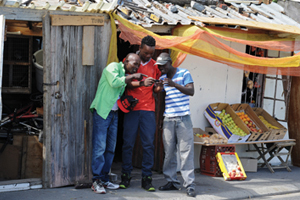Major boost for mobile video streaming
11 January 2013
The dearth of high speed broadband has opened the door for the mobile revolution that is sweeping through Africa. By far more people use their cellphones than computers for connectivity, but unbroken streaming of video in low bandwidth areas has remained a problem. Up until now, that is.
A group of UCT researchers - working in a consortium with developers from the CSIR (Council for Scientific and Industrial Research) and marketing experts from East Coast Access - have come up with an innovative solution that is likely to change the face of mobile usage for watching video across the continent.
The platform - known as Adaptive Real-Time Internet Streaming Technology (ARTIST) - makes constant video streaming possible with the use of algorithms to adjust quality to available bandwidth. "Our aim was to find the balance between complete blockage due to congestion and acceptable picture/video quality in order to lessen the disruption to the viewing experience of the user," explains Emeritus Professor Gerhard De Jager.
He, along with Associate Professor Mqhele Dlodlo, headed up the team of researchers in UCT's Department of Electrical Engineering which developed the intellectual property (IP) for Artist. Dlodlo is involved in the university's Communications Research Group while De Jager is part of the Image Processing Group.
This breakthrough is likely to have a major impact across the globe, but most notably in Africa itself where accessible bandwidth is still an issue. The world's largest video platform, YouTube, streams six billion hours of video each month, but a large part of the developing world is missing out. The International Telecommunication Union (ITU) estimates that fixed (read: high speed) broadband penetration is less than 1% in sub-Saharan Africa, compared to about 27.2% in developed nations.
For mobile subscriptions, however, Africa isn't nearly as far behind the rest of the world as it is with high-speed broadband. The ITU reports that per 100 inhabitants, Africa has around 63.5 mobile subscriptions, while Asian regions are at 88.7, Europe is at 126.5 and the Americas are at 109.4 mobile subscriptions per 100 inhabitants.
"Potential applications for this technology are diverse - from entertainment (sports events, community TV) to education (schooling, adult education and healthcare worker training)," says Dlodlo.
Earlier this year the ARTIST project won a NSTF-BHP Billiton Award in the category 'An Individual or Team who delivered an Outstanding Contribution to SETI through Research Leading to Innovation'. In reaction to this accolade Dlodlo thanked the postgraduate students without whom, he says, this project would not have been so successful.
UCT's involvement started in May 2008 and stretched over three years. The project was piloted on the Johannesburg-based commercial radio station YFM in September 2011. "We chose a radio station because it only uses voice broadcasts and therefore operates on a low bandwidth channel. We tested our video compression techniques by adding a TV channel to the offering which proved to be very successful," clarified Dlodlo.
The company tasked with commercialising ARTIST is Tuluntulu (the Zulu word for stream). Its CEO Pierre van der Hoven believes the benefit of this technology is twofold, "We can go into rural (low bandwidth) areas and by managing the signal we can control the cost to end-users"
The Tuluntulu app is available on Google Play Store to anyone with an Android device running version 4.0 or later. Van der Hoven is currently in the process of selling the platform to content owners and television channels among others.
"We're open to doing business with anyone who needs to communicate visually. There's no limit to the number of channels that can run on the platform. If you have viable visual content, we can accommodate you," he added.
Story by Abigail Calata. Image by Michael Hammond.
 This work is licensed under a Creative Commons Attribution-NoDerivatives 4.0 International License.
This work is licensed under a Creative Commons Attribution-NoDerivatives 4.0 International License.
Please view the republishing articles page for more information.










